Now that Rosetta has been delayed indefinitely from its original mission to visit Comet Wirtanen, technicians have to dismantle the spacecraft and return each scientific instrument to the researchers who built them. The mission was cancelled because a recent report indicated that the Ariane 5 rocket was unsafe to launch. Rosetta’s original target was Comet Schwassmann-Wachmann 3, then Comet Wirtanen, so now planners are considering Comets Finlay, Brooks 2 and Wild 2. There’s no scheduled launch date, though.
Columbia Launches on Science Mission
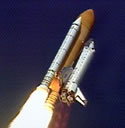
Image credit: NASA
The Space Shuttle Columbia lifted off from Cape Canaveral yesterday, carrying the first Israeli astronaut and six crewmates on a scientific mission. Columbia blasted off at 1539 GMT (10:39 am EST) and reached orbit 9 minutes later. The astronauts have a total of 80 experiments to perform over the next 16 days.
Columbia lifted off from the Kennedy Space Center this morning on the first shuttle mission of the year, carrying the first Israeli astronaut into orbit along with six crewmates on a marathon international scientific research flight.
Commander Rick Husband, Pilot Willie McCool, Mission Specialists Dave Brown, Kalpana Chawla and Laurel Clark, Payload Commander Mike Anderson and Payload Specialist Ilan Ramon of the Israel Space Agency blasted off at 9:39 a.m. CST from Launch Pad 39-A. Less than nine minutes later, Columbia settled into an orbit inclined 39 degrees to the equator.
The seven astronauts will divide their duties into two teams working 12-hour shifts to conduct round-the-clock science. Aboard Columbia more than 80 experiments dealing with astronaut health and safety, advanced tehnology development and Earth and space sciences.
Husband, Chawla, Clark and Ramon comprise the Red team which will work in the pre-dawn and daytime hours, while McCool, Brown and Anderson make up the Blue team, working the evening and overnight hours.
Once in orbit, the crewmembers will begin to unstow gear and prepared for the opening of Columbia’s payload bay doors, before activating hardware and experiments in a double Spacehab research module housed in the shuttle’s cargo bay, which contains the lion’s share of the mission’s science. Other experiments housed in the cargo bay also will be activated, along with a special pallet of cryogenic fuel tanks at the rear of the cargo bay which will provide Columbia and its experiments sufficient electrical power for the duration of the flight.
Having shifted their sleep schedule to accommodate the dual-shift operations, McCool, Brown and Anderson will begin an abbreviated six-hour sleep period at 1:39 p.m. CST and will be awakened at 7:39 p.m. while Red team counterparts continue the early stages of experiment activation. Husband, Chawla, Clark and Ramon will begin an eight-hour sleep period at 8:39 p.m. and will be awakened Friday at 4:39 a.m. to handover work from the Blue team which will be continuing the initial phase of scientific studies overnight.
As Columbia was launched, the Expedition 6 crew aboard the International Space Station was orbiting over the northern Pacific Ocean south of the Aleutian island chain. Commander Ken Bowersox, Flight Engineer Nikolai Budarin and NASA ISS Science Officer Don Pettit are in their 54th day in space, their 52nd day on board the station.
The next STS-107 mission status report will be issued this evening, or earlier if events warrant.
Original Source: NASA News Release
NASA Announces Shuttle Launch Time
NASA announced the official launch time of the Space Shuttle Columbia on Wednesday, as part of its new policy of keeping the time secret until 24 hours before launch. If all goes well, the shuttle will lift off from Florida’s Cape Canaveral at 1539 GMT (10:39 am EST). The shuttle won’t dock with the International Space Station this mission, so there is a long launch window of 2.5 hours. The weather looks excellent for launch.
QuikScat Captures Images of Melting Ice Shelf
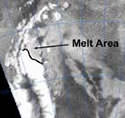
Image credit: NASA
An instrument on board NASA’s Quick Scatterometer spacecraft has detected the earliest melting in Antarctica’s Larsen Ice Shelf. This huge plate of glacier-fed ice has been disintegrating since 1995, losing nearly 10-percent of its size (more than two trillion tonnes of ice), and the most recent chunk disappeared due to a cyclone that sent warm weather into the area.
An international research team using data from NASA’s SeaWinds instrument aboard the Quick Scatterometer spacecraft has detected the earliest yet recorded pre-summer melting event in a section of Antarctica’s Larsen Ice Shelf. This huge, nearly 200 meter (656 foot) thick plate of glacier-fed floating ice, which in the late 1980s was about as large as Indiana, experienced dramatic disintegration events beginning in 1995 that have reduced its area by nearly 10 percent, or more than two trillion tons of ice.
Researchers Dr. Mark Drinkwater of the European Space Agency, Dr. David Long of Brigham Young University and Dr. Steve Harangozo of the British Antarctic Survey used near real time Quick Scatterometer (QuikScat) data to document a rapid, extensive melting of the Larsen C Ice Shelf in Antarctica’s Weddell Sea from Oct. 27 to Oct. 29, 2002. The melting, which extended to 68 degrees south, was triggered by a mid-latitude cyclone that delivered warm air to the region. The same storm is believed to have also caused a noticeable recession in the sea-ice margin to the west of the Antarctic Peninsula. The QuikScat images are available at: http://photojournal.jpl.nasa.gov/catalog/PIA03894
Air temperatures in the region typically exceed freezing for a few days on or after November 1 each year-a precursor to sustained summer melting that normally sets in several weeks later at these latitudes. The cumulative duration of these annual summer melting events is likely to have increased substantially over the past 50 years as summer average air temperatures on the eastern side of the Antarctic Peninsula have warmed appreciably (approximately two degrees Celsius, or 3.6 degrees Fahrenheit). Scientists believe these events are responsible for the previous breakups of Larsen and other ice shelves. Therefore, the ability to observe such events in near real time using scatterometers is of great interest to researchers, since they may provide invaluable clues to the fate of other, much larger Antarctic ice shelves.
While scientists used to believe there was no connection between recent Antarctic Peninsula warming and the natural cycle of deglaciation, recent field measurements provide some evidence to suggest the frequency of summer melting, and the resulting quantities of melt water penetrating ice shelves, may be connected with the accelerated disintegration of Larsen and other Antarctic ice shelves.
“The water is believed to penetrate cracks and fissures in the ice and refreeze at depth, where the ice is relatively colder,” said Drinkwater. “As the ice expands, this process effectively drives a wedge into existing cracks to accelerate the natural fracture process.”
Scatterometers operate by transmitting high-frequency microwave pulses to Earth’s surface and measuring the “backscattered,” or echoed, radar pulses bounced back to the satellite. Moshe Pniel, scatterometer projects manager at NASA’s Jet Propulsion Laboratory, Pasadena, Calif., which developed and manages the instruments, said scatterometers such as SeaWinds on QuikScat and a similar SeaWinds instrument on Japan’s recently launched Advanced Earth Observing Satellite 2 (Adeos 2), are proving to be increasingly important in monitoring land and ice processes.
“Scatterometers can effectively and quickly detect the difference between melting and dry surfaces,” he said. “They provide an important new tool in our capability to monitor climate change impacts on the Antarctic ice cover on a daily basis. These scatterometer data are vital in the southern hemisphere because near real time synthetic aperture radar data is not available there on a frequent, uninterrupted basis. QuikScat measurements being compiled and archived in the Scatterometer Climate Record Pathfinder study by Long and Drinkwater (http://www.scp.byu.edu) enable critical assessments of the links between changes taking place in global ice cover and associated changes in important elements of Earth’s closely-linked ocean-atmosphere climate system.”
QuikScat measurements and image data developed by Long are processed and distributed in near real time by the National Oceanic and Atmospheric Administration, providing scientists at the British Antarctic Survey and elsewhere with rapid access to low-resolution radar data that can be used to report melt events. The British Antarctic Survey compiles and distributes Antarctic Meteorological Station data in near real time.
More information about SeaWinds is available at: http://winds.jpl.nasa.gov/index.html.
NASA’s Earth Science Enterprise is a long-term research effort to understand and protect our home planet. The California Institute of Technology in Pasadena manages JPL for NASA.
Original Source: NASA/JPL News Release
Where Should the Next Martian Rovers Land?
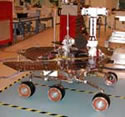
Image credit: NASA
With only a few months to go before NASA launches its next two rovers to Mars, mission planners need to pin down exactly where they want the robot explorers to touch down. The twin Mars Exploration Rovers are scheduled for launch in May and June of 2003, and they currently have four candidate landing locations picked out – each of which offers unique terrain to explore. The final decision will be made in April.
The launch dates for the two Mars Exploration Rovers are getting closer and so is the need to pick a place for them to land.
Adventurous travelers might spin a globe and pick a vacation based on whichever spot their finger finds. But scientists and engineers working on NASA’s newest rover mission cannot be as casual about landing site choices for the twin rovers that will launch in May and June of this year.
Last week, team members and others from the scientific community met for a final chance to discuss and fine-tune the pros and cons of each of the four landing site contenders.
Images and data from two other NASA spacecraft currently orbiting the red planet — Mars Global Surveyor and Mars Odyssey — have provided invaluable information on possible landing sites.
“This is a unique period where we have orbital missions that can help us make the selection,” said Dr. Matt Golombek, JPL landing site scientist. “We want to go to sites with terrains that will challenge our minds but not the safety of the rovers.”
Since the rovers do not have the luxury of landing on a well-paved runway, JPL geologists and engineers must carefully choose an area without large rocks that could damage the rovers’ airbag landing system. Also, an area that is too densely populated with rocks of any size could prevent the rover from moving freely. Winds in the lower atmosphere are also an important consideration, as are the slopes the airbag-clad lander impact against.
Adequate exposure to the sun is vital for the solar-powered rovers. Geologists have chosen sites near the equator where there is sufficient sunlight. The sites are also relatively free of accumulations of iron-oxide dust particles that can coat solar panels and interfere with the rovers’ mobility.
Like the final four in any competition, each of the four Mars candidates is a potential winner.
“Three of the sites, Terra Meridiani, known as the Hematite site, Gusev, and Isidis show evidence for surface processes involving water. These sites appear capable of addressing the science objectives of the rover missions: to determine if water was present on Mars and whether there are conditions favorable to the preservation of evidence for ancient life,” said Golombek.
The fourth site, Elysium, appears to contain ancient terrain, which may hold clues to Mars’ early climate when conditions may have been wetter.
Over the next several months, geologists and engineers will continue to analyze the viability of each site. The final decision will be made by NASA in April, shortly before the rovers begin their journey to Mars.
Original Source: NASA/JPL News Release
Two Astronauts Go for a Spacewalk
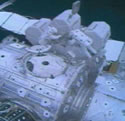
Image credit: NASA
Astronauts Donald Pettit and Kenneth Bowersox enjoyed their first ever walk in space on Wednesday as they performed some maintenance work on the International Space Station. The walk was slightly delayed because of a sticky hatch, but after about 20 minutes they made it outside the station. They spent a total of 6 hours and 51 minutes outside the station.
Expedition 6 Commander Ken Bowersox and NASA Science Officer Don Pettit continued the assembly of the International Space Station today and set the stage for a series of complex shuttle construction flights to the complex later this year during a 6-hour, 51-minute spacewalk staged out of the Quest Airlock.
The spacewalk, which was the first for both Bowersox and Pettit, was the 50th excursion in support of the assembly and maintenance of the ISS, the 25th originated from the Station itself and the 16th conducted from Quest. Russian cosmonaut Nikolai Budarin supported the spacewalk from inside the ISS, acting as the spacewalk choreographer while operating television cameras on the Canadarm2 robotic arm.
After encountering some difficulty opening the airlock hatch due to a strap on the inside of the thermal hatch cover, the hatch finally swung open and Bowersox and Pettit began their spacewalk at 6:50 a.m. Central time by placing their suits on internal battery power. As he did, Bowersox reported a loss of digital data for his suit systems, requiring him to recycle his suit power that cleared up the momentary glitch. Once outside, Bowersox and Pettit quickly set up tools and gear, then moved to the recently installed Port One (P1) Truss segment, where they released ten remaining launch restraints from the truss? radiator system. Eight others had been released when the truss was delivered to the ISS last November on the STS-113 mission.
Flight controllers then sent commands to unfurl the P1?s center radiator, enabling it to extend to its fully deployed length of 75 feet, preparing the system for its activation later this year to provide cooling for station systems. The deployment took only 9 minutes to complete.
After inspecting some hardware on the P1 Truss for engineers on the ground, the two spacewalkers made their way to the Unity connecting node, where Pettit used Kapton tape to dab away small amounts of grit from a sealing ring on the nadir Common Berthing Mechanism, leaving the CBM in a pristine condition for the attachment of the Raffaello Multi-Purpose Logistics Module during the next shuttle flight to the station in March.
Bowersox and Pettit were unable to complete one minor task, the installation of a stanchion and a light fixture on one of two handcarts located on the Starboard One (S1) Truss which future spacewalkers will use to transport themselves up and down the station?s truss system. The stanchion would not release from its stowed position on the truss, apparently because of a pin interfering with its movement, and the task, considered a low priority for today?s spacewalk, was deferred to a future Expedition excursion.
As they neared the end of their spacewalk, Bowersox and Pettit returned to the center of the station, as Pettit retrieved tools from a storage box on the Z1 Truss and conducted a health check on an ammonia reservoir that was delivered to the P6 solar array truss structure in 2001. That ammonia system will be used to partially fill the cooling loops of the P1 Truss on an intricate shuttle assembly flight later this year that will occur in the midst of the reconfiguration of station power systems.
As they reentered the Quest Airlock, Bowersox and Pettit used a scissors to cut away the strap on the hatch cover which interfered with the rotation of the hatch handle at the start of the spacewalk. The hatch closed normally with no further problems expected in the future.
With their work completed, Bowersox and Pettit completed their spacewalk at 1:41p.m. Central time, raising the total spacewalk time for ISS assembly and maintenance to 312 hours and 11 minutes.
Before the spacewalk began, robotic engineers in Mission Control sent commands to move the station?s Mobile Transporter from the far end of the P1 Truss to its normal parking place at the centermost S0 Truss segment to protect its umbilical cable from any potential damage from orbital debris. The Transporter began its move from the P1 Truss to the S0 Truss at 1:53 a.m. Central time, latching itself in place about 20 minutes later.
The transporter is used to maneuver the Canadarm2 space crane up and down the length of the station?s trusses for assembly work. It had been parked on the P1 Truss during the STS-113 mission when it ran into a communication antenna on the truss, delaying its use for one of that flight?s spacewalks. Today, it moved back to its normal parking place uneventfully.
Bowersox, Budarin and Pettit will enjoy an off-duty day Thursday in the wake of today?s spacewalk before resuming their normal complement of scientific experiments and ISS housekeeping on Friday.
Original Source: NASA News Release
Nearest Brown Dwarf Found
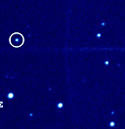
Image credit: ESO
A team of European astronomers have located the closest brown dwarf star ever discovered. Epsilon Indi, located only 12 light-years from the Earth, was thought to be a single star, but the ESO team spotted its companion. Epsilon Indi B is 45 times the mass of Jupiter and takes 400 years to orbit the main star.
A team of European astronomers [2] has discovered a Brown Dwarf object (a ‘failed’ star) less than 12 light-years from the Sun. It is the nearest yet known.
Now designated Epsilon Indi B, it is a companion to a well-known bright star in the southern sky, Epsilon Indi (now “Epsilon Indi A”), previously thought to be single. The binary system is one of the twenty nearest stellar systems to the Sun.
The brown dwarf was discovered from the comparatively rapid motion across the sky which it shares with its brighter companion : the pair move a full lunar diameter in less than 400 years. It was first identified using digitised archival photographic plates from the SuperCOSMOS Sky Surveys (SSS) and confirmed using data from the Two Micron All Sky Survey (2MASS). Follow-up observations with the near-infrared sensitive SOFI instrument on the ESO 3.5-m New Technology Telescope (NTT) at the La Silla Observatory confirmed its nature and has allowed measurements of its physical properties.
Epsilon Indi B has a mass just 45 times that of Jupiter, the largest planet in the Solar System, and a surface temperature of only 1000 ?C. It belongs to the so-called ‘T dwarf’ category of objects which straddle the domain between stars and giant planets.
Epsilon Indi B is the nearest and brightest T dwarf known. Future studies of the new object promise to provide astronomers with important new clues as to the formation and evolution of these exotic celestial bodies, at the same time yielding interesting insights into the border zone between planets and stars.
Tiny moving needles in giant haystacks
Imagine you are a professional ornithologist, recently returned home from an expedition to the jungles of South America, where you spent long weeks using your high-powered telephoto lenses searching for rare species of birds. Relaxing, you take a couple of wide-angle snapshots of the blooming flowers in your back garden, undistracted by the common blackbird flying across your viewfinder. Only later, when carefully comparing those snaps, you notice something tiny and unusually coloured, flittering close behind the blackbird: you’ve discovered an exotic, rare bird, right there at home.
In much the same way, a team of astronomers [2] has just found one of the closest neighbours to the Sun, an exotic ‘failed star’ known as a ‘brown dwarf’, moving rapidly across the sky in the southern constellation Indus (The Indian). Interestingly, at a time when telescopes are growing larger and are equipped with ever more sophisticated electronic detectors, there is still much to be learned by combining old photographic plates with this modern technology.
Photographic plates taken by wide-field (“Schmidt”) telescopes over the past decades have been given a new lease on life through being digitised by automated measuring machines, allowing computers to trawl effectively through huge and invaluable data archives that are by far not yet fully exploited [3]. For the Southern Sky, the Institute for Astronomy in Edinburgh (Scotland, UK) has recently released scans made by the SuperCOSMOS machine of plates spanning several decades in three optical passbands. These data are perfectly suited to the search for objects with large proper motions and extreme colours, such as brown dwarfs in the Solar vicinity.
Everything is moving – a question of perspective
In astronomy, the `proper motion’ of a star signifies its apparent motion on the celestial sphere; it is usually expressed in arcseconds per year [4]. The corresponding, real velocity of a star (in kilometres per second) can only be estimated if the distance is known.
A star with a large proper motion may indicate a real large velocity or simply that the star is close to us. By analogy, an airplane just after takeoff has a much lower true speed than when it’s cruising at high altitude, but to an observer watching near an airport, the departing airplane seems to be moving much more quickly across the sky.
Proxima Centauri, our nearest stellar neighbour, is just 4.2 light-years away (cf. ESO PR 22/02) and has a proper motion of 3.8 arcsec/year (corresponding to 23 km/sec relative to the Sun, in the direction perpendicular to the line-of-sight). The highest known proper motion star is Barnard’s Star at 6 light-years distance and moving 10 arcsec/year (87 km/sec relative to the Sun). All known stars within 30 light-years are high-proper-motion objects and move at least 0.2 arcsec/year.
Trawling for fast moving objects
For some time, astronomers at the Astrophysical Institute in Potsdam have been making a systematic computerised search for high-proper-motion objects which appear on red photographic sky plates, but not on the equivalent blue plates. Their goal is to identify hitherto unknown cool objects in the Solar neighbourhood.
They had previously found a handful of new objects within 30 light-years in this way, but nothing as red or moving remotely as fast as the one they have now snared in the constellation of Indus in the southern sky. This object was only seen on the very longest-wavelength plates in the SuperCOSMOS Sky Survey database. It was moving so quickly that on plates taken just two years apart in the 1990s, it had moved almost 10 arcseconds on the sky, giving a proper motion of 4.7 arcsec/year. It was also very faint at optical wavelengths, the reason why it had never been spotted before. However, when confirmed in data from the digital Two Micron All Sky Survey (2MASS), it was seen to be much brighter in the infrared, with the typical colour signature of a cool brown dwarf.
At this point, the object was thought to be an isolated traveller. However, a search through available online catalogues quickly revealed that just 7 arcminutes away was a well-known star, Epsilon Indi. The two share exactly the same very large proper motion, and thus it was immediately clear the two must be related, forming a wide binary system separated by more than 1500 times the distance between the Sun and the Earth.
Epsilon Indi is one of the 20 nearest stars to the Sun at just 11.8 light years [5]. It is a dwarf star (of spectral type K5) and with a surface temperature of about 4000 ?C, somewhat cooler than the Sun. As such, it often appears in science fiction as the home of a habitable planetary system [6]. That all remains firmly in the realm of speculation, but nevertheless, we now know that it most certainly has a very interesting companion.
This is a remarkable discovery: Epsilon Indi B is the nearest star-like source to the Sun found in 15 years, the highest proper motion source found in over 70 years, and with a total luminosity just 0.002% that of the Sun, one of the intrinsically faintest sources ever seen outside the Solar System!
After Proxima and Alpha Centauri, the Epsilon Indi system is also just the second known wide binary system within 15 light years. However, unlike Proxima Centauri, Epsilon Indi B is no ordinary star.
Brown dwarfs: cooling, cooling, cooling …
Within days of its discovery in the database, the astronomers managed to secure an infrared spectrum of Epsilon Indi B using the SOFI instrument on the ESO 3.5-m New Technology Telescope (NTT) at the La Silla Observatory (Chile). The spectrum showed the broad absorption features due to methane and water steam in its upper atmosphere, indicating a temperature of ‘only’ 1000 ?C. Ordinary stars are never this cool – Epsilon Indi B was confirmed as a brown dwarf.
Brown dwarfs are thought to form in much the same way as stars, by the gravitational collapse of clumps of cold gas and dust in dense molecular clouds. However, for reasons not yet entirely clear, some clumps end up with masses less than about 7.5% of that of our Sun, or 75 times the mass of planet Jupiter. Below that boundary, there is not enough pressure in the core to initiate nuclear hydrogen fusion, the long-lasting and stable source of power for ordinary stars like the Sun. Except for a brief early phase where some deuterium is burned, these low-mass objects simply continue to cool and fade slowly away while releasing the heat left-over from their birth.
Theoretical discussions of such objects began some 40 years ago. They were first named ‘black dwarfs’ and later ‘brown dwarfs’, in recognition of their predicted very cool temperatures. However, they were also predicted to be very faint and very red, and it was only in 1995 that such objects began to be detected.
The first were seen as faint companions to nearby stars, and then later, some were found floating freely in the Solar neighbourhood. Most brown dwarfs belong to the recently classified spectral types L and T, below the long-known cool dwarfs of type M. These are very red to human eyes, but L and T dwarfs are cooler still, so much so that they are almost invisible at optical wavelengths, with most of their emission coming out in the infrared. [7].
How massive is Epsilon Indi B?
The age of most brown dwarfs detected to date is unknown and thus it is hard to estimate their masses. However, it may be assumed that the age of Epsilon Indi B is the same as that of Epsilon Indi A, whose age is estimated to be 1.3 billion years based on its rotational speed. Combining this information with the measured temperature, brightness, and distance, it is then possible to determine the mass of Epsilon Indi B using theoretical models of brown dwarfs.
Two independent sets of models yield the same result: Epsilon Indi B must have a mass somewhere between 4-6% of that of the Sun, or 40-60 Jupiter masses. The most likely value is around 45 Jupiter masses, i.e. well below the hydrogen fusion limit, and definitively confirming this new discovery as a bona-fide brown dwarf.
The importance of Epsilon Indi B
PR Photo 03c/03 shows the current census of the stars in the solar neighbourhood. All these stars have been known for many years, including GJ1061, which, however, only had its distance firmly established in 1997. The discovery of Epsilon Indi B, however, is an extreme case, never before catalogued, and the first brown dwarf to be found within the 12.5 light year horizon.
If current predictions are correct, there should be twice as many brown dwarfs as main sequence stars. Consequently, Epsilon Indi B may be the first of perhaps 100 brown dwarfs within this distance, still waiting to be discovered!
Epsilon Indi B is an important catch well beyond the cataloguing the Solar neighbourhood. As the nearest and brightest known brown dwarf and with a very accurately measured distance, it can be subjected to a wide variety of detailed observational studies. It may thus serve as a template for more distant members of its class.
With the help of Epsilon Indi B, astronomers should now be able to see further into the mysteries surrounding the formation and evolution of the exotic objects known as brown dwarfs, halfway between stars and giant planets, the physics of their inner cores, and the weather and chemistry of their atmospheres.
An historical note – the southern constellation Indus
The constellation Indus lies deep in the southern sky, nestled between three birds, Grus (The Crane), Tucana (The Toucan) and Pavo (The Peacock), cf. PR Photo 03d/03.
First catalogued in 1595-1597 by the Dutch navigators Pieter Dirkszoon Keyser and Frederick de Houtman, this constellation was added to the southern sky by Johann Bayer in his book ‘Uranometria’ (1603) to honour the Native Americans that European explorers had encountered on their travels.
In particular, it has been suggested that it is specifically the native peoples of Tierra del Fuego and Patagonia that are represented in Indus, just over two thousand kilometres south of La Silla where the first spectroscopic observations of Epsilon Indi B were made some 400 years later.
In the later drawing by Bode shown here, Epsilon Indi, the fifth brightest star in Indus, is associated with one of the arrows in the Indian’s hand.
Original Source: ESO News Release
Supernova Won’t Destroy the World
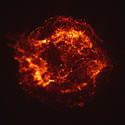
Image credit: Hubble
Just in case you were worried, it appears that a supernova would have to be really really close to the Earth before it could cause massive damage to our environment. Scientists at NASA and Kansas University used data from a recent exploding star to determine that a supernova would have to be only 26 light-years away in order to strip away the ozone layer – an encounter that only happens once every 670 million years.
We have one less thing to worry about. While the cosmic debris from a nearby massive star explosion, called a supernova, could destroy the Earth’s protective ozone layer and cause mass extinction, such an explosion would have to be much closer than previously thought, new calculations show.
Scientists at NASA and Kansas University have determined that the supernova would need to be within 26 light years from Earth to significantly damage the ozone layer and allow cancer-causing ultraviolet radiation to saturate the Earth’s surface.
An encounter with a supernova that close only happens at a rate of about once in 670 million years, according to Dr. Neil Gehrels of NASA’s Goddard Space Flight Center in Greenbelt, Md., who presents these findings today at the American Astronomical Society meeting in Seattle.
“Perhaps a nearby supernova has bombarded Earth once during the history of multicellular life with its punishing gamma rays and cosmic rays,” said Gehrels. “The possibility for mass extinction is indeed real, yet the risk seems much lower than we have thought.”
The new calculations are based largely on advances in atmospheric modeling, analysis of gamma rays produced by a supernova in 1987 called SN1987a, and a better understanding of galactic supernova locations and rates. A supernova is an explosion of a star at least twice as massive as our Sun.
Previous estimates from the 1970s stated that supernovae as far as 55 light years from Earth could wipe out up to 90 percent of the atmosphere for hundreds of years. The damage would be from gamma rays and cosmic rays, both prodigiously emitted by supernovae. Gamma rays are the most energetic form of light. Cosmic rays are atomic particles, the fastest-moving matter in the Universe, produced when the expanding shell of gas from the exploded star runs into surrounding dust and gas in the region. Gamma rays, moving at light speed, would hit the Earth’s atmosphere first, followed closely by the cosmic rays moving at close to light speed.
Gamma-ray light particles (called photons) and the cosmic-ray particles can wreak havoc in the upper atmosphere, according to Dr. Charles Jackman of NASA Goddard, who provided the atmospheric analysis needed for the new calculation.
The particles collide with nitrogen gas (N2) and break the molecule into highly-reactive nitrogen atoms (N). The nitrogen atoms then react fairly quickly with oxygen gas (O2) to form nitric oxide (NO) and, subsequently, other nitrogen oxides (NOx). The nitrogen oxide molecules can then destroy ozone (O3) through a catalytic process. This means that a single NOx molecule can destroy an ozone molecule and remain intact to destroy hundreds of more ozone molecules.
The new calculations — based on the NASA Goddard two-dimensional photochemical transport model — show that a supernova within 26 light years from Earth could wipe out 47 percent of the ozone layer, allowing approximately twice the amount of cancer-causing ultraviolet radiation to reach the Earth’s surface. Excessive UV radiation is harmful to both plants and animals, thus a doubling of UV levels would be a significant problem to life on Earth.
The gamma-ray irradiation would last 300 to 500 days. The ozone layer would then repair itself, but only to endure cosmic-ray bombardment shortly after, lasting at least 10 years. (Cosmic rays are electrically charged particles whose paths are influenced by magnetic fields, and the extent of such fields in the interstellar medium is not well understood.)
The calculations simultaneously point to the resilience of the ozone layer as well as its fragility in a violent Universe, said Dr. Claude Laird of the University of Kansas, who developed the gamma-ray and cosmic ray input code and performed the atmospheric model simulations. Although the ozone layer should recover relatively rapidly once the particle influx tapers off — within about one to two years, the Goddard models show — even this short period of time is sufficient to cause significant and lasting damage to the biosphere.
“The atmosphere usually protects us from gamma rays, cosmic rays, and ultraviolet radiation, but there’s only so much hammering it can take before Earth’s biological defenses break down,” he said.
Dr. John Cannizzo of NASA Goddard and University of Maryland, Baltimore Country, initiated and coordinated the new calculations. “I’ve long been fascinated by the possibility of extinction from something as remote as a star explosion,” he said. “With this updated calculation, we essentially worked backwards to determine what level of ozone damage would be needed to double the level of ultraviolet radiation reaching the Earth’s surface and then determined how close a supernova would need to be to cause that kind of damage.”
These results will appear in the Astrophysical Journal 2003, March 10, vol. 585. Co-authors include Barbara Mattson of NASA Goddard (via L3 Com Analytics Corporation) and Wan Chen of Sprint IP Design in Reston, Virginia.
Original Source: NASA News Release
Rosetta Launch Postponed Indefinitely
Just a day after they announced that Rosetta could be flying by the end of the month, the European Space Agency decided to put the mission on hold indefinitely because of their concerns with the Ariane-5 rocket. Unfortunately, since Rosetta won’t be launching by the end of the month, it won’t be able to meet up with Comet Wirtanen. by 2011, so the entire mission will need to be redesigned to seek a new target.
Three new moons discovered for Neptune
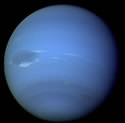
Image credit: NASA
A team of astronomers from the Harvard-Smithsonian Center for Astrophysics have discovered three previously unknown moons orbiting the planet Neptune. Since they’re only 30-40km across, the moons were a challenge to spot. The team had to digitally merge multiple exposures of the planet moving across a background of stars. Over time, the planets and their motions were picked up as points of light. This brings the gas giant’s total to 11 known moons.
A team of astronomers led by Matthew Holman (Harvard-Smithsonian Center for Astrophysics) and JJ Kavelaars (National Research Council of Canada) has discovered three previously unknown moons of Neptune. This boosts the number of known satellites of the gas giant to eleven. These moons are the first to be discovered orbiting Neptune since the Voyager II flyby in 1989, and the first discovered from a ground-based telescope since 1949.
It now appears that each giant planet’s irregular satellite population is the result of an ancient collision between a former moon and a passing comet or asteroid. “These collisional encounters result in the ejection of parts of the original parent moon and the production of families of satellites. Those families are exactly what we’re finding,” said Kavelaars.
The team that discovered these new satellites of Neptune includes Holman and Kavelaars, graduate student Tommy Grav (University of Oslo & Harvard-Smithsonian Center for Astrophysics), and undergraduate students Wesley Fraser and Dan Milisavljevic (McMaster University, Hamilton, Ontario, Canada).
Needle in a Haystack
The new satellites were a challenge to detect because they are only about 30-40 kilometers (18-24 miles) in size. Their small size and distance from the Sun prevent the satellites from shining any brighter than 25th magnitude, about 100 million times fainter than can be seen with the unaided eye.
To locate these new moons, Holman and Kavelaars utilized an innovative technique. Using the 4.0-meter Blanco telescope at the Cerro Tololo Inter-American Observatory, Chile, and the 3.6-meter Canada-France-Hawaii Telescope, Hawaii, they took multiple exposures of the sky surrounding the planet Neptune. After digitally tracking the motion of the planet as it moved across the sky, they then added many frames together to boost the signal of any faint objects. Since they tracked the planet’s motion, stars showed up in the final combined image as streaks of light, while the moons accompanying the planet appeared as points of light.
Prior to this find, two irregular satellites and six regular satellites of Neptune were known. The two irregular satellites are Triton, discovered in 1846 by William Lassell, and Nereid, discovered in 1949 by Gerard Kuiper. Triton is considered irregular because it orbits the planet in a direction opposite to the planet’s rotation, indicating that Triton is likely a captured Kuiper Belt Object. (The Kuiper Belt is a disk-shaped collection of icy objects that circle the Sun beyond the orbit of Neptune.) Nereid is considered irregular because it has a highly elliptical orbit around Neptune. In fact, its orbit is the most elliptical of any satellite in the solar system. Many scientists believe that Nereid once was a regular satellite whose orbit was disrupted when Triton was gravitationally captured. The six regular satellites were discovered by the Voyager probe during its encounter with Neptune. The three new satellites were missed by Voyager II because of their faintness and great distance from Neptune. According to Holman, “The discovery of these moons has opened a window through which we can observe the conditions in the solar system at the time the planets were forming.”
Tracking Faint Blips
The researchers are currently conducting follow-up observations to better define the orbits of the newfound moons using orbital predictions supplied by Brian Marsden (Director of the Minor Planet Center in Cambridge, Mass.) and Robert Jacobson (Jet Propulsion Laboratory).
To follow up the initial find, team members Brett Gladman (University of British Columbia, Canada); Jean-Marc Petit, Philippe Rousselot, and Olivier Mousis (Observatoire de Besancon, France); and Philip Nicholson and Valerio Carruba (Cornell University) conducted additional observations using the Hale 5-meter telescope on Mount Palomar and one of the four 8.2-meter telescopes of the European Southern Observatory’s Very Large Telescope at Paranal Observatory, Chile. Grav made additional tracking observations using the 2.6-meter Nordic Optical Telescope on La Palma, Spain.
Holman says, “Tracking these moons is an enormous, international undertaking involving the efforts of many people. Without teamwork, such faint objects could be easily lost.”
Based in La Serena, Chile, the Cerro Tololo Inter-American Observatory is part of the National Optical Astronomy Observatory, which is operated by the Association of Universities for Research in Astronomy, Inc., under a cooperative agreement with the National Science Foundation.
The Canada-France-Hawaii Telescope is operated by the CFHT Corporation under a joint agreement between the National Research Council of Canada, the Centre National de la Recherche Scientifique of France, and the University of Hawaii.
The European Southern Observatory is an intergovernmental, European organization for astronomical research. It has ten member countries. ESO operates astronomical observatories in Chile and has its headquarters in Garching, near Munich, Germany.
Headquartered in Cambridge, Massachusetts, the Harvard-Smithsonian Center for Astrophysics (CfA) is a joint collaboration between the Smithsonian Astrophysical Observatory and the Harvard College Observatory. CfA scientists organized into six research divisions study the origin, evolution, and ultimate fate of the universe.
Original Source: CfA News Release
